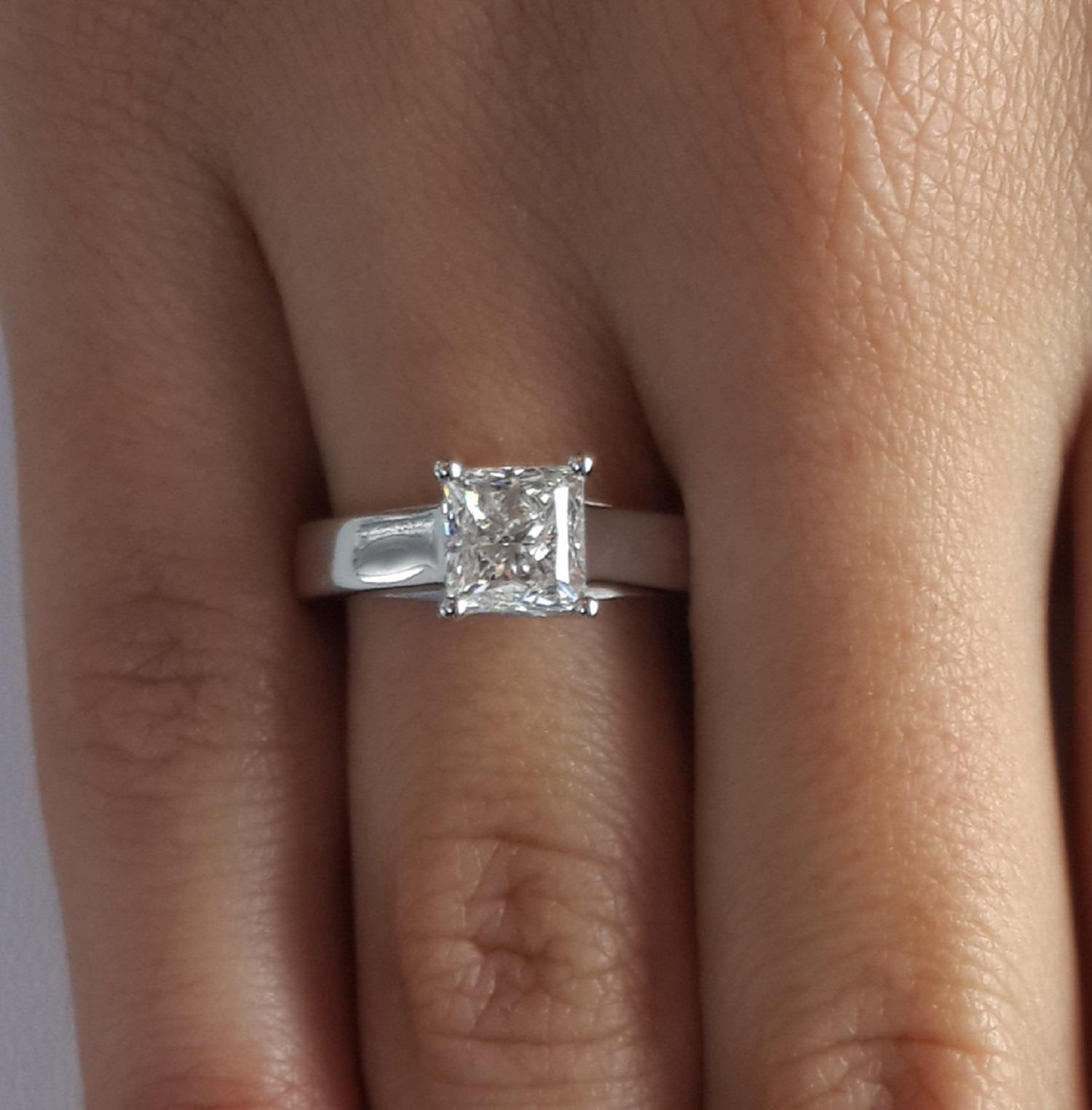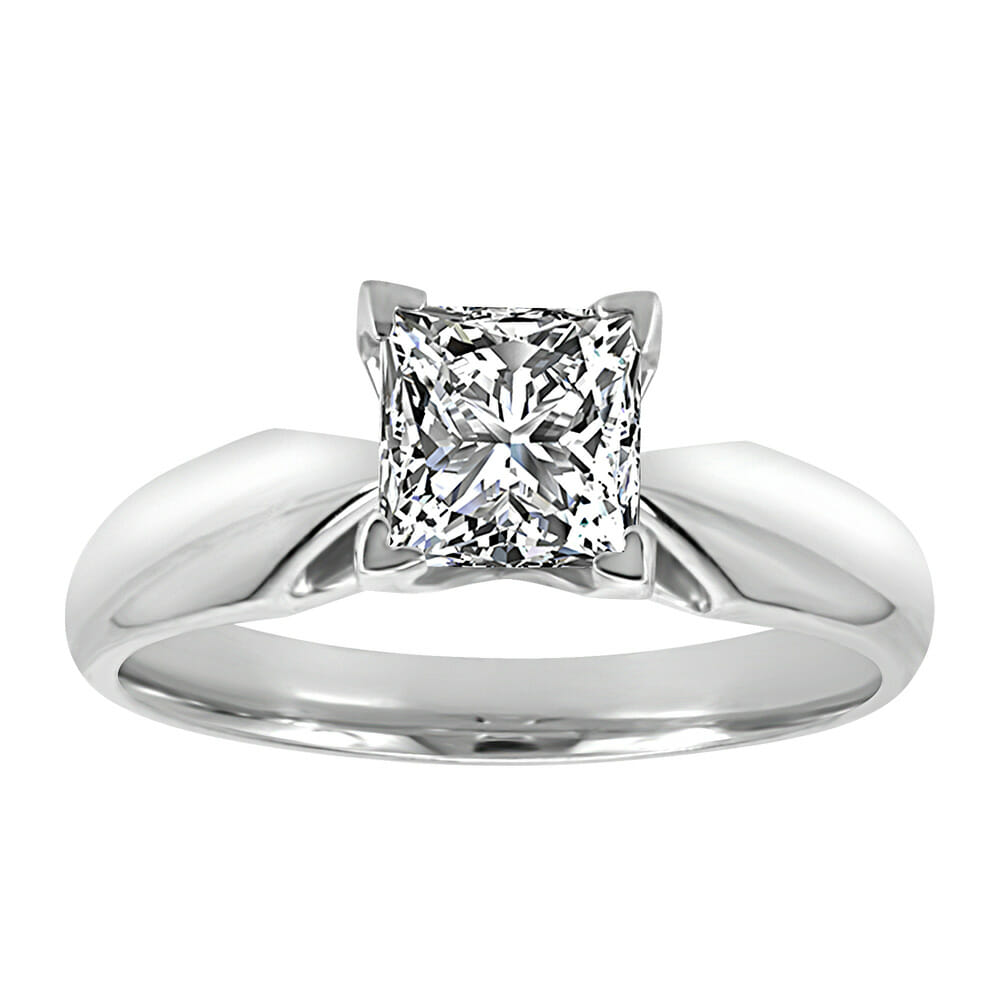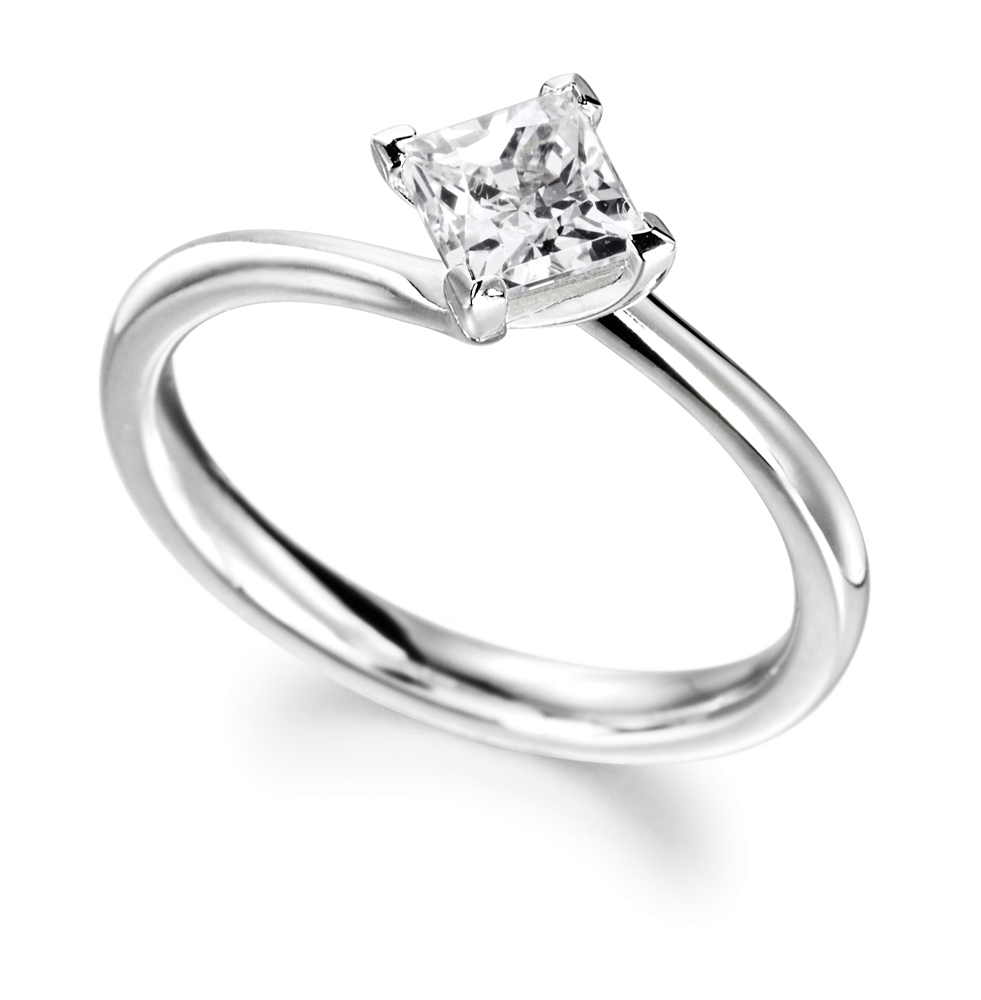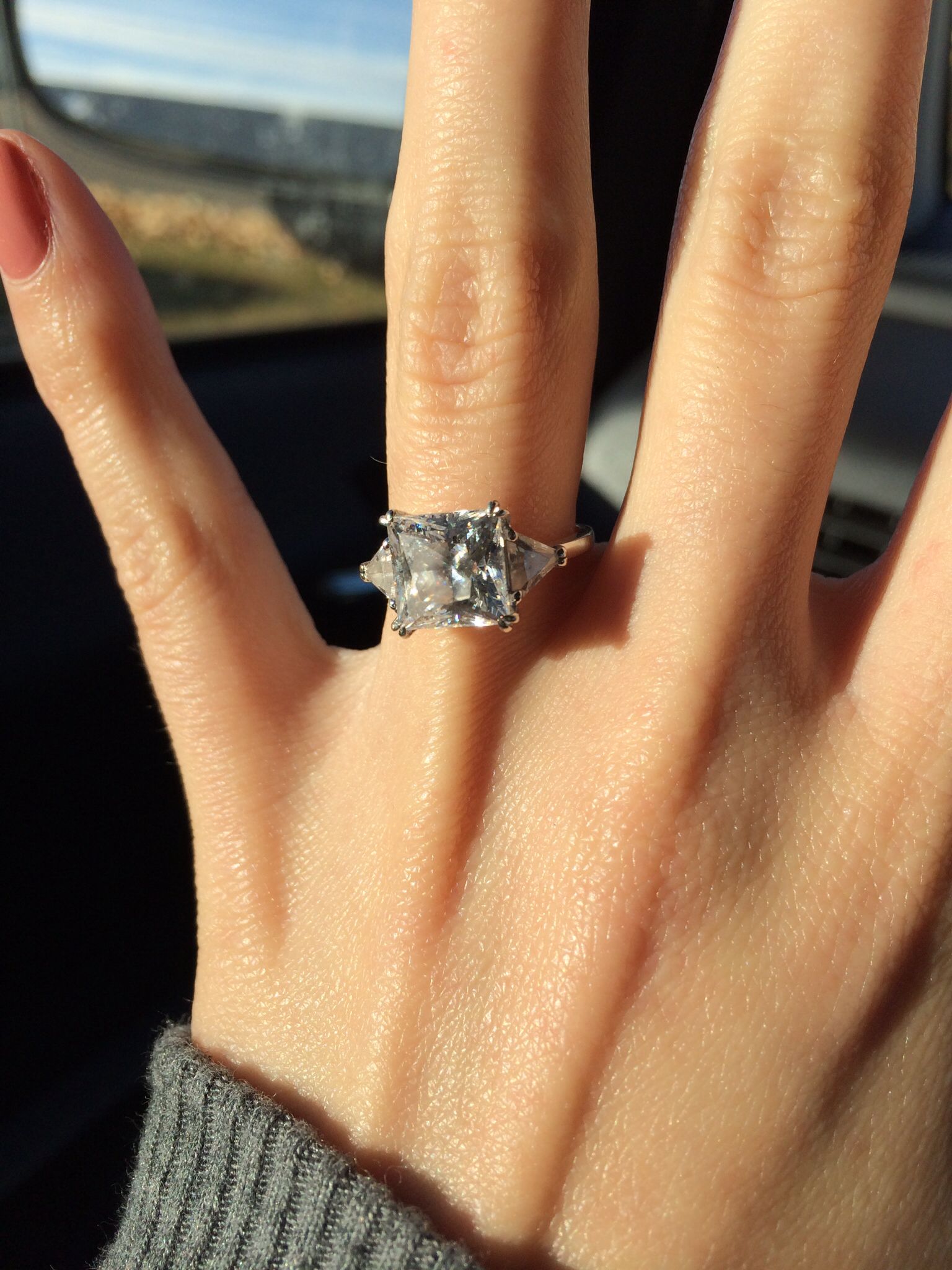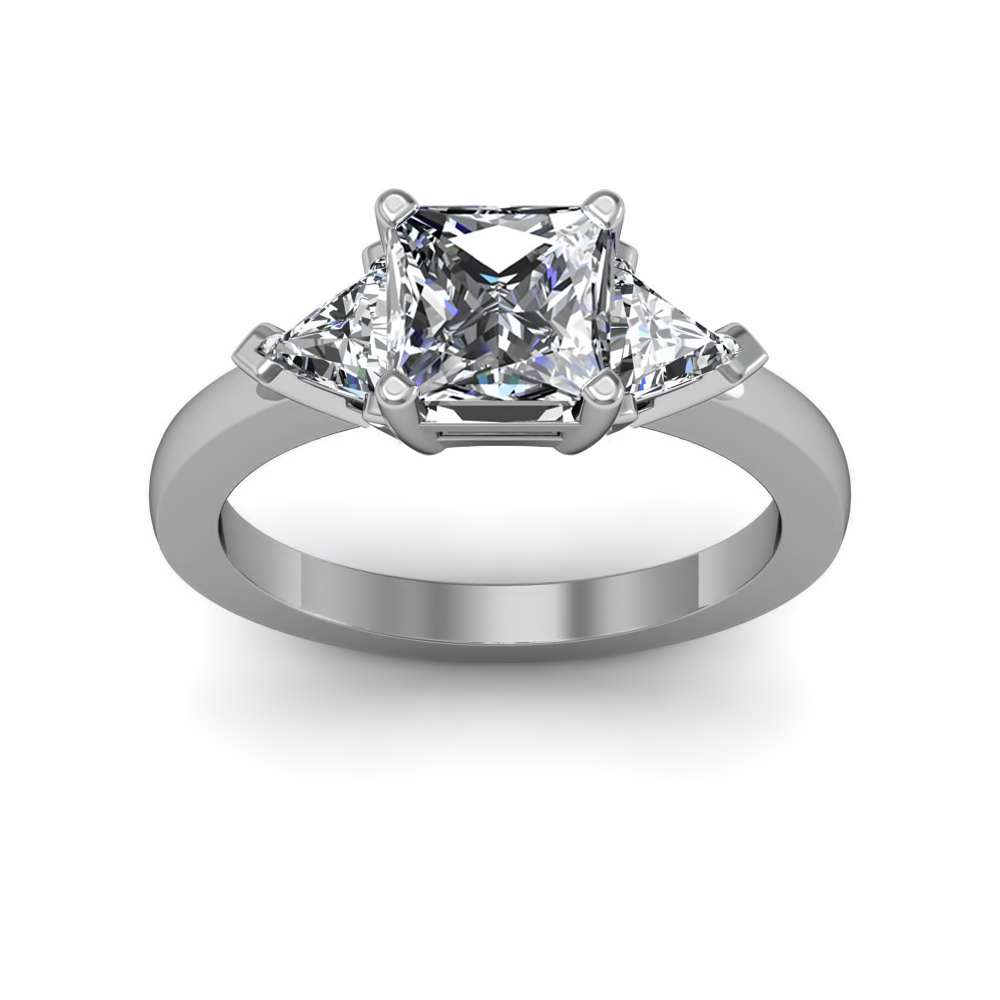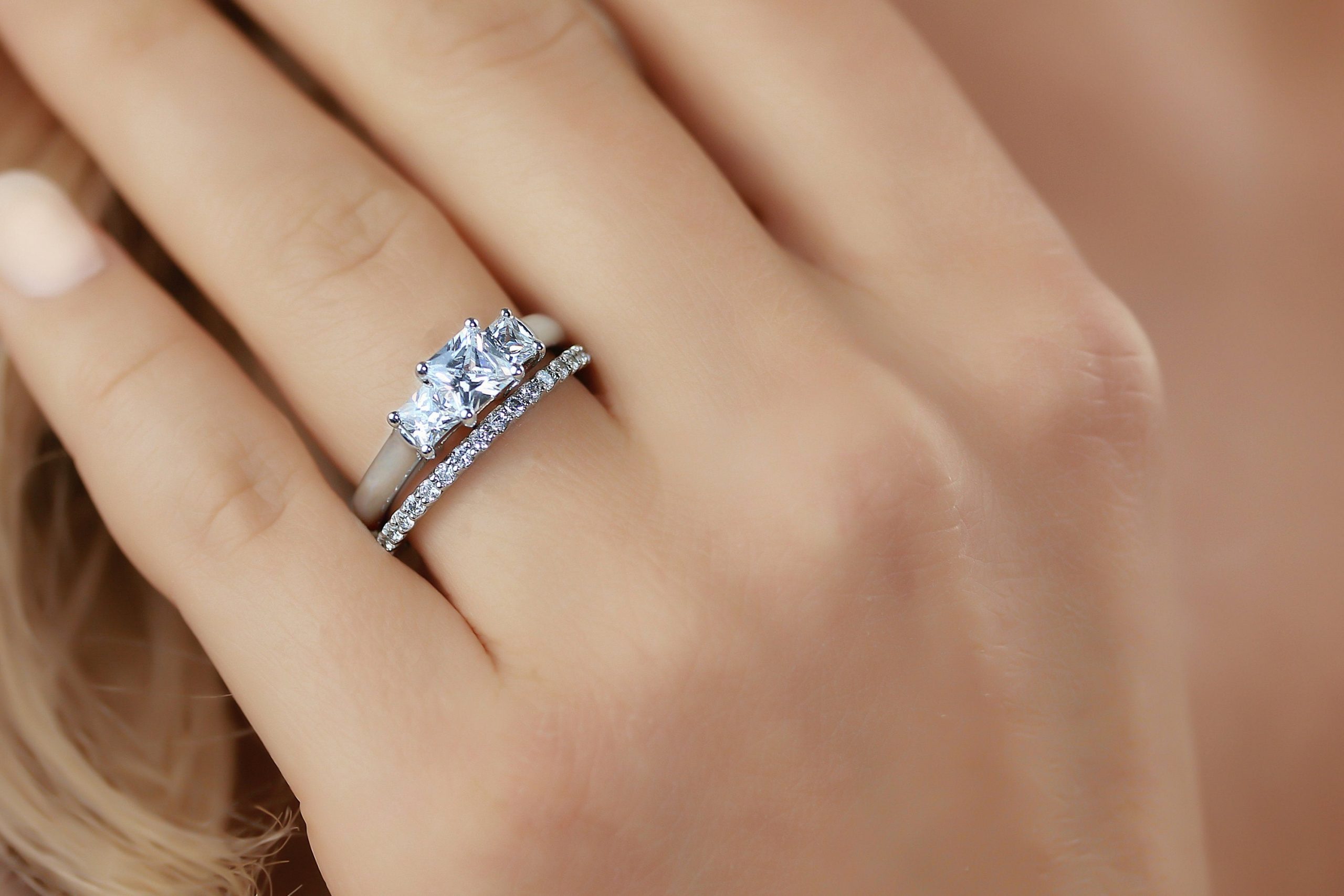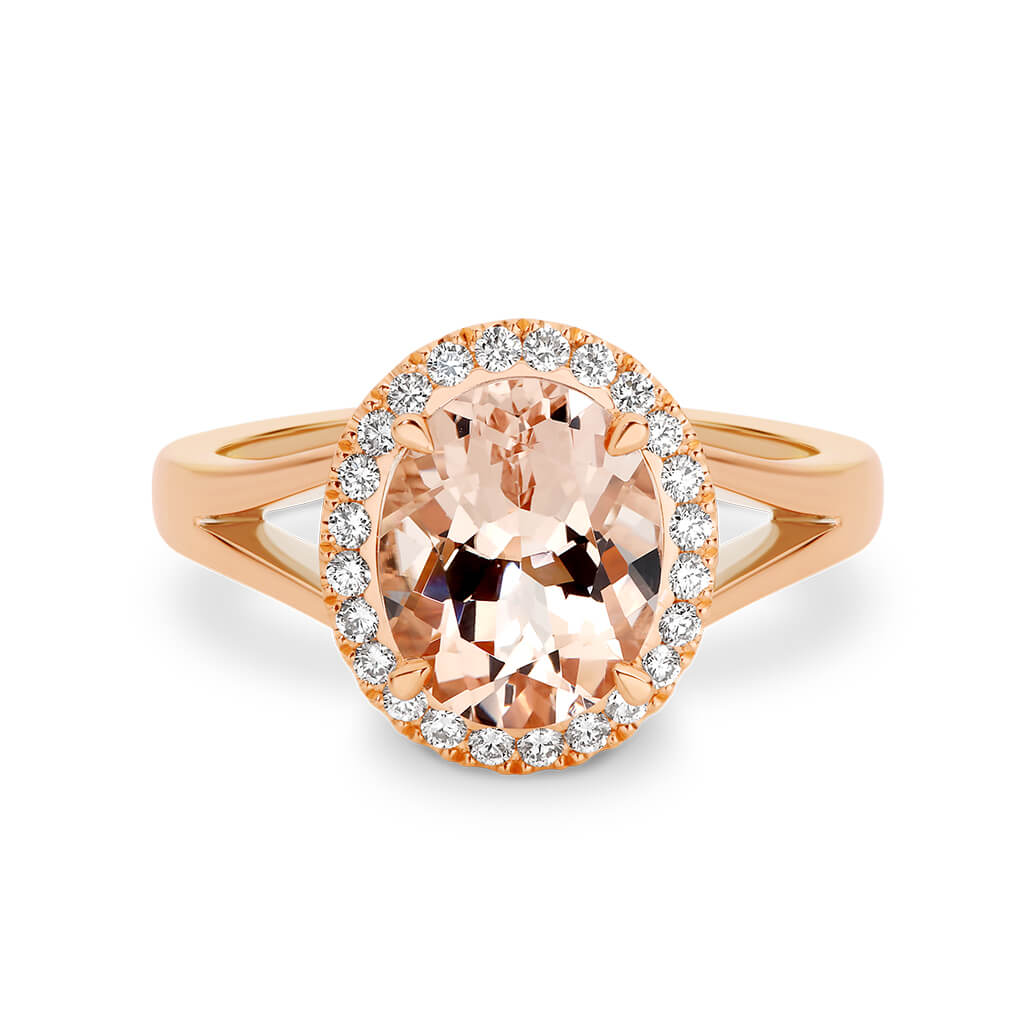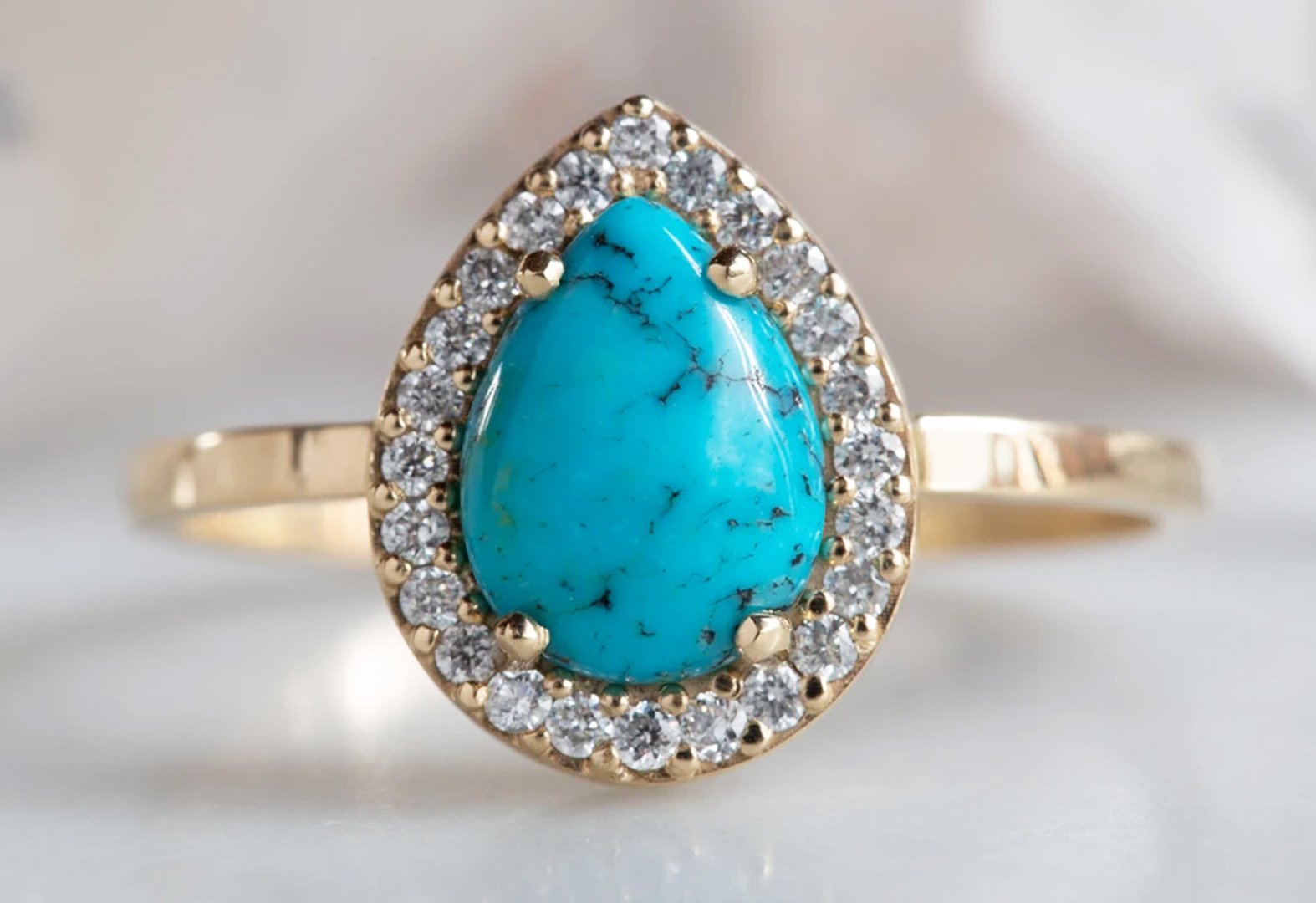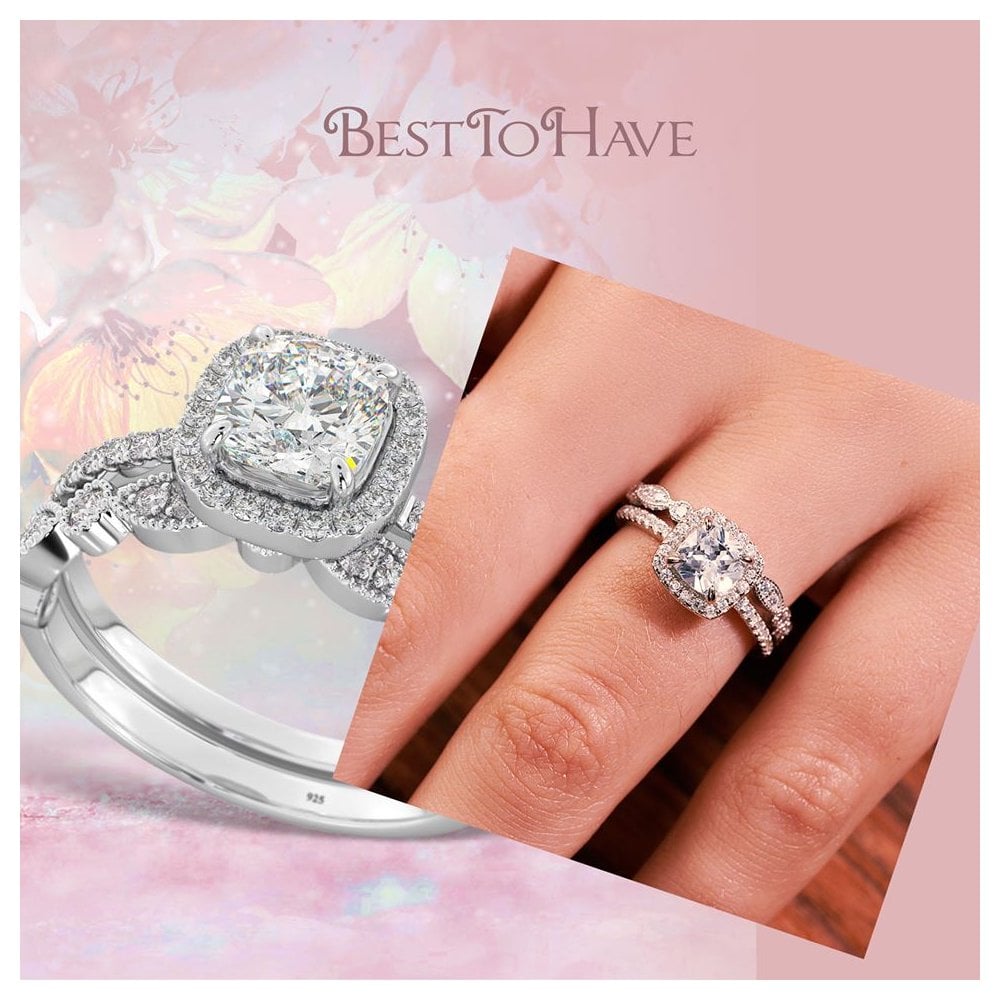A. Princess Cut Diamond: Cut Quality & Engagement Ring Settings
1. What is a princess cut diamond?
A princess cut diamond is traditionally a square diamond that offers excellent fire and brilliance. This fancy shaped diamond is designed from the inverted pyramid of rough diamond stone. Princess cuts are among the most brilliant of all diamond shapes and are a popular choice for engagement rings.
The highest quality Princess Cuts cuts have a pronounced square shape with a length/width ratio of 1.0-1.05. While you can find princess rectangular cuts, they are undesirable because they may lack luster. Princess cuts with excellent or ideal cut quality create breathtaking engagement rings.
Main features of a Princess Cut diamond:
- The brightest square diamond.
- Includes two to four chevron patterns.
- It costs less per carat than round cuts because more of the rough stone is retained during the cutting process.
- A popular choice for engagement rings and earrings.
- Also known as Modified Glossy Square and Modified Glossy Rectangular, although rectangular princess cuts are not welcome.
2. How many facets does a princess cut diamond have?
A princess cut diamond usually has between 50 and 58 facets, depending on how the diamond is cut. Most facets are on the pavilion and crown, with some on the belt. Princess cuts also typically have two to four chevron patterns, which are crisscross patterns that can be seen by looking at the top diamond. When a diamond has two chevron patterns, the diamond reflects more powerful flashes of white and colored light. When a diamond has four chevron patterns, the diamond has more sparkle – resulting in more smaller flashes of white and colored light that can be seen as the diamond moves. Take a look at each Princess Cut diamond to make sure it delivers the sparkle and fire you’ve been looking for. Feel free to contact our experts for a second opinion before making your selection.
3. The Princess Cut – The modern cut is gaining in popularity
According to the Wikipedia article on Diamond Cut, the modern princess cut was first introduced in 1960 by A. Nagy of London. The Princess Cut is widely considered the Round Brilliant runner-up in the market today. According to the Jogia Diamonds blog table that I refer to in my diamond shapes article, 23% of the searches on your site are for Princess Cuts. It’s still a long way from 64% for Round Brilliants, but keep in mind that Emerald Cut came in second with just 3% of the polls. Princess Cut is right at number 2.
4. A dream for diamond makers
As I mentioned in my article on diamond shapes, the princess cut is one of the favorite diamond cutters for one very important reason – its raw material yield. Look at the photo on the left. Now imagine cutting this piece of rough in half. What would basically be left are two princess cuts! All that’s left is to add some texture and shiny cut to the top of the stone. Now imagine how much diamond material you would lose if you cut a Round Glitter from this rough piece. The difference is quite stark.
a. Why princess cut diamonds are cheaper
A brilliant cut round diamond is usually around 40% (meaning that a 1 carat sawn rough piece gives a round polished diamond of 0.40ct), while a princess cut is in the 80%-90% range! This is the main reason why, all other things being equal, a princess cut is cheaper than a round diamond. Another result of this phenomenon is that, as princess cuts are made only from very high quality and very well shaped rough diamond crystals, this generally correlates with a cleaner rough.
b. Purity degrees
This selection of purity grades for princess cut diamonds is primarily aimed at high quality products. You will never find a wide variety of SI2 and I1 princess cuts. In fact, this was always a problem for my former employer Leo Schachter, as they provided great princess cut programs to major retail chains. It has always been a problem to meet the needs of the SI2 and I1 Princess Cut. On the other hand, the fact that they have larger tables means that an SI grade diamond will likely not be as clean on the eyes as you can see from this diamond. There is a greater chance that it will be visible if you look directly at the diamond.
c. Eye cleaning is extremely important.
In our opinion, the consumer’s goal should be to find the cheapest (in terms of clarity; other factors play a role) “eye-clean” diamond you can find. We use “eye cleaning” to describe diamonds that may have inclusions when you look at them with a magnifying glass (or a microscope or a magnifying glass), but the typical person cannot see the inclusions with the naked eye. We recently developed Ringo, a patented artificial intelligence model that can examine videos of diamonds and determine if they are clean for the eyes. Ringo also filters out other parameters, eg B. To make sure the diamond is well cut, has no fluorescence issues and conforms to the style setting you have chosen.
5. Buy the best diamond for a princess cut engagement ring
Now that you’re more familiar with Princess Cut’s history, let’s get right to the information that’s relevant to the consumer. Before getting into that, check out the size differences between the various carat weights compared to a quarter in the US.
a. Color
When it comes to color, you need to be a little more careful with a Princess Cut Diamond than a Round Brilliant. As both are glossy cuts, they both manage to cut light, making it harder to see the true color of the raw material. But since the Round Brilliant’s light return is superior, it’s also better to keep your diamond’s true color a secret. For this reason, when purchasing a Princess Cut diamond, I recommend that you choose an H- or I-Color diamond for the best value. As you can see on this stunning diamond, a princess cut in color can look perfectly clear, as long as the proportions are right and the eyes are clear.
b. Things to consider
You can go higher than H, but personally I don’t think the increasing whiteness you’ll gain is worth the extra price you’ll have to pay. One thing to keep in mind, however, is that if you’re buying your diamond to put in an engagement ring, you’ll need to make sure that the color of the center stone matches the color of the highlight diamonds. Unless you’re opting for a yellow gold or rose gold setting, I don’t recommend the J color with princess cuts, as they retain a little more color than round diamonds.
c. Clarity
In terms of clarity, a Princess Cut is similar to a Round Brilliant in that it’s a decent hiding place for inclusions. One thing to keep in mind with Princess Cuts, however, is that there are serious durability issues. As Princess Cuts have four sharp corners, they tend to chip (and you thought diamonds have been around forever!). If there is an inclusion in any of the four corners of the diamond, the probability of the diamond chipping greatly increases. Buying the diamond in a ring is less of a problem, unless you think you might want to replace the stone in a new ring in the future.
d. Recommended clarity for princess cuts
At Round Brilliant Cuts, I recommend buying SI2s or even I1s that have been proven to be clean. It’s a little more complicated with Princess Cuts because they’re so rare. So, at Princess Cuts, I recommend buying VS2 or SI1 Clarity diamonds that have been confirmed to be eye clean (you can do this with a tool like James Allen’s virtual magnifying glass). Princess Cut SI2 and I1 clear diamonds are very scarce due to the high quality of the rough diamonds from which Princess Cut diamonds are cut, but if you can find one that is clean on the eyes, it will offer incredible value.
e. Cut quality
Perhaps the hardest part of buying the best stone for a princess cut diamond ring is the quality of the cut. It’s easy with turns. The GIA gives their opinion and you can trust them. However, with Princess Cuts you are practically alone. The GIA only evaluates polish and symmetry on a Princess Cut diamond. Unlike Rounds, there’s really no industry-wide consensus on what parameters make the perfect princess cut.
There are, of course, good reasons for this. As I mentioned before, the entire creation of this cut was born out of the desire to minimize diamond loss in the polishing pad. In contrast to premium cut round diamonds, princess cuts are cut to fit the shape of the blank piece, not the other way around.
f. Diamond in the rough
Therefore, if a piece of rough diamond is shaped like a well-proportioned princess cut diamond, it will end up being one. But if a diamond in the rough is shaped like a very deep and disproportionate princess cut, then unfortunately it will too. It is precisely for this reason that diamond cutters do not want to be forced to adhere to a certain Princess Cut diamond pattern. You need the flexibility to be able to combine the cut diamond with the rough diamond.
g. Recommendation for general depth
Look for an overall depth between 65% and 75%. In general, the smaller the better. I prefer stones in the 68% to 73% range. They seem to give the best balance between shine and size. For the table percentage, I recommend staying below 75%. In general, there are two schools of thought about Princess Cut table sizes. If you focus on small table princess cuts, they will generally look best with depth percentages in the 74-77% range.
h. Tables and Depth Gauges Schools of Thought
One warehouse bets on small tables (68% and less), while others claim it doesn’t really matter, so go with what the raw produces naturally – slightly larger tables in the 73% -78% range to stock up to handle the creeping depths in the 76/77% range. Small desks are a serious minority in the industry. So be aware that it may be harder for you to find a diamond if you like it. If you’re interested in fantastic alternatives to our traditional princess tailoring recommendations, check out Brian Gavin’s Princess Tailoring or Blue Nile’s Astor Princess Tailoring.
General recommendations on cutting parameters for princess cut diamonds:
- Depth: 68% to 75% (below 70% is very hard to find)
- Table: Below 75% (There are two schools of thought, Small Table School and Normal Table School. Try looking at both – below 68% and above 70% and see which one you prefer. Just a note – small tables are much harder to find)
- Polish / Symmetry: Good, Very Good or Excellent
- Length/width ratio: 1.00 to 1.05 for Square Princess Cut
6. Best setting for a princess cut diamond ring
The best ring settings for Princess diamond rings are channel and four prong settings – like a solitaire or three stone ring. With the sharp edges of a princess cut, it’s important to make sure the corners don’t peel or get damaged. A set of channels or four tips provide protection without obscuring the diamond’s beauty. Since Princess Cuts are very versatile, there are several impressive configuration options. Here is the complete list of the best settings for Princess Cut diamond rings.
a. Lonely
A solitaire setting allows the princess’ cut to be the center of attention and let in as much light as possible. This classic solitaire is an excellent example of a princess cut engagement ring that makes a statement.
b. Duct set
A channel setup provides Princess Cuts security. This fine gold engagement ring is a lovely choice, as is this 1/4 carat engagement ring.
c. Gloriole
Halo engagement rings have smaller diamonds that surround the center stone, making it look even larger. Here is a 1 carat princess-cut platinum halo ring, and a more delicate style can be seen in this princess-cut rose gold halo ring.
d. Vintage
Old style rings have more elaborate and exclusive features like this James Allen royal princess cut ring or this Blue Nile milgrain ring.
B. White Gold Diamond Engagement Rings: The Complete Guide
When looking for the perfect engagement ring, there are a number of important decisions you need to make, what type of center stone you like best and what type of metal the band will be. White gold diamond engagement rings are a very popular option and for good reason: white gold is beautiful to look at, very versatile and quite easy to care for.
1. What is white gold?
White gold is an alloy of gold and at least one other white metal such as palladium, nickel, zinc, copper or silver. As jewelry expert Kim Kanary explains, white gold takes on its characteristic silvery white hue thanks to a very thin layer of rhodium. When gold is mixed with another white metal, “the resulting color is still a dull gray to brownish yellow”, which requires a rhodium plating to achieve a white shine.
2. Pros and Cons of White Gold and Diamond Engagement Rings
One of the biggest advantages of a white gold ring is that the bracelet has a neutral silver hue that doesn’t affect the center stone at all. “Gemstones reflect the color of the metal they are placed in, which means that colorless gemstones (such as diamonds) can be tinted if the surrounding metal contains color,” says Kanary. This can happen with certain yellow gold settings, but not white gold. “Your gem will reflect the silvery white metal, which will result in no noticeable color difference in your stone.” Also, white gold tends to be brighter and less matte, making the metal a valuable but inexpensive option.
While white gold is more durable than yellow gold, it doesn’t do justice to a metal like platinum. White gold is still suitable for everyday use, but it is softer than platinum and therefore scratchable more easily. She adds: “The purest form of gold is the yellow color, which means you can only get a white color by diluting the purity. If you are interested in a higher degree of fineness, white gold may not be your best option. ”
3. What To Look For In A White Gold And Diamond Engagement Ring
- Are there any allergies to diamond rings made of white gold? White gold is usually alloyed with nickel. So if you’re allergic to nickel, stay away from white gold.
- What is the difference between white gold and platinum? White gold is often seen as a cost-effective alternative to platinum, but there’s a reason platinum is more expensive. According to Kanary, platinum is more durable and therefore more resistant to daily wear and tear and offers more security for the center stone studs than white gold. “It is also denser than gold. If all other qualities are equal, a platinum ring is heavier than a white gold ring,” she adds.
- How durable is white gold? As white gold and yellow gold are gold, there is not much difference between the two. The biggest difference, however, is that yellow gold is purer than white gold because white gold is gold mixed with other metals. Kanary says, “Pure natural gold is yellow in color. The greater the purity, the more yellow it becomes.” But while yellow gold may be purer, it’s also inherently softer, meaning white gold is the most durable option.
- How does the cost of white gold compare to platinum? White gold is a cheaper alternative to platinum.
